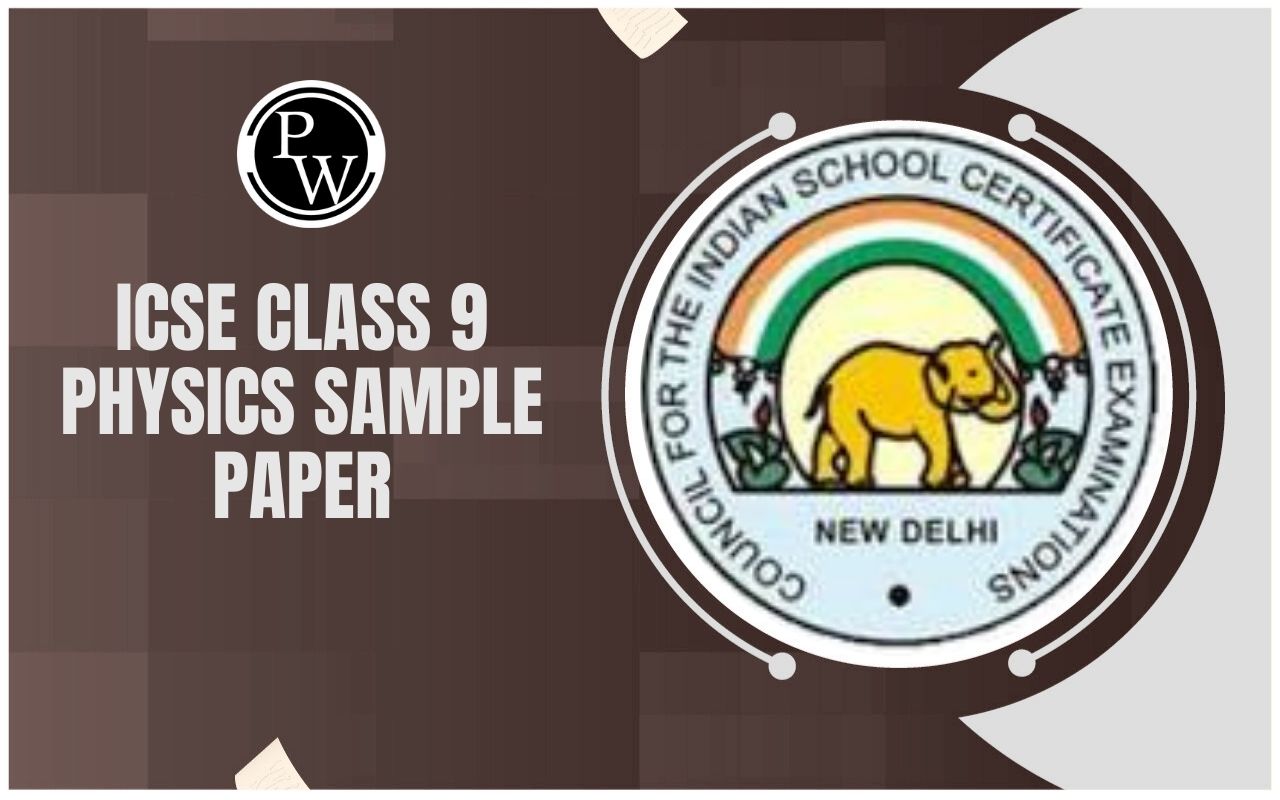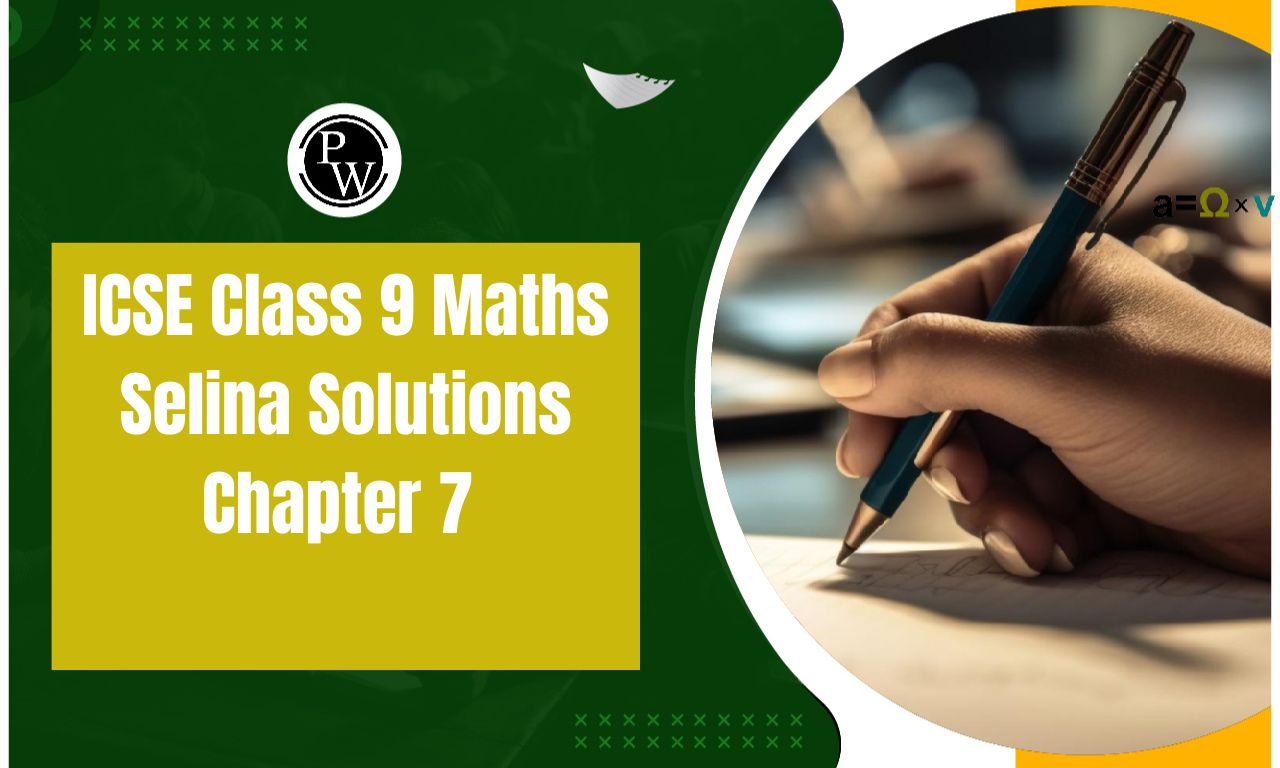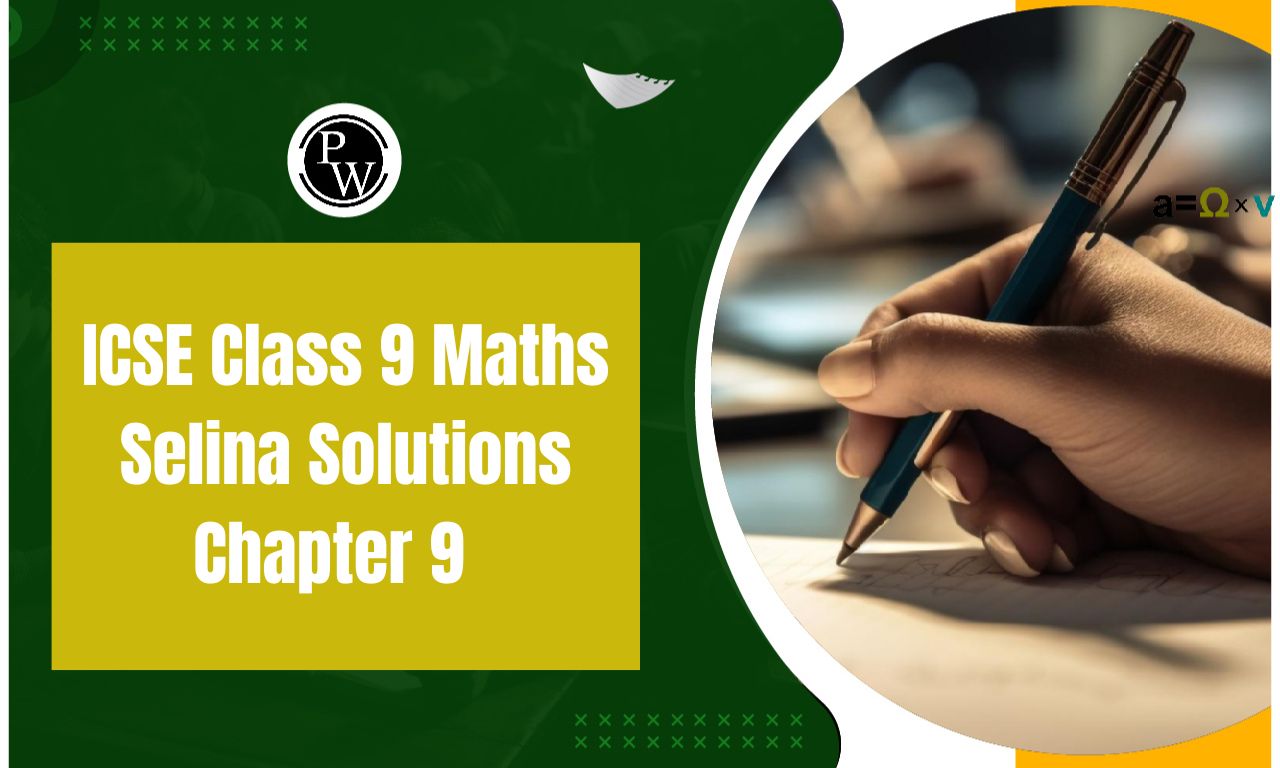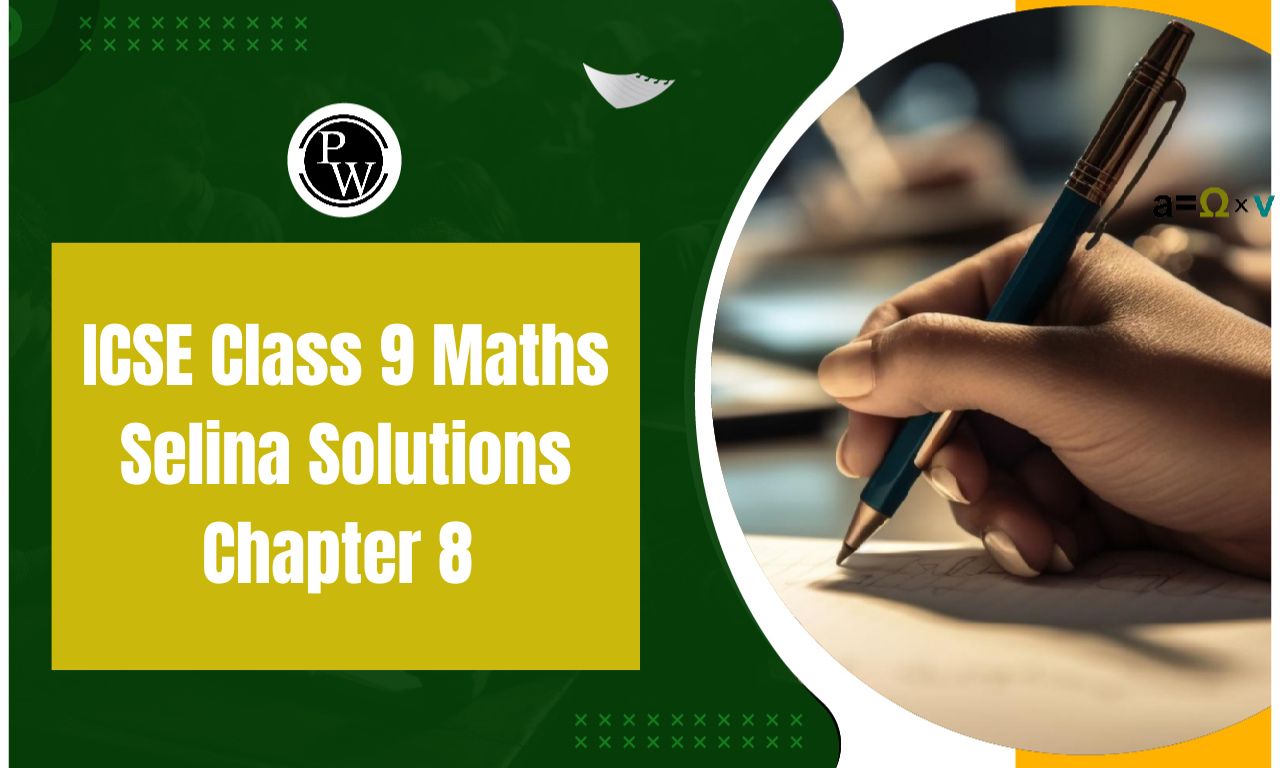
ICSE Class 9 Maths Selina Solutions Chapter 1: ICSE Class 9 Maths Selina Solutions Chapter 1 focuses on rational and irrational numbers. It helps students understand the differences between these types of numbers and their unique properties.
The solutions provided by Selina Publishers explain these concepts clearly with easy-to-follow examples. By studying this chapter students can build a strong foundation in mathematics and improve their skills in solving problems related to rational and irrational numbers.ICSE Class 9 Maths Selina Solutions Chapter 1 Rational And Irrational Numbers Overview
The ICSE Class 9 Maths Selina Solutions Chapter 1 on Rational and Irrational Numbers prepared by subject experts from Physics Wallah. This chapter explains the differences between rational and irrational numbers, and how they work. The solutions are easy to understand, with step-by-step explanations to help students solve problems confidently. By using practical examples, these solutions aim to help students improve their understanding of rational and irrational numbers, making them well-prepared for exams and assignments.ICSE Class 9 Maths Selina Solutions Chapter 1 PDF
You can find the PDF link for ICSE Class 9 Maths Selina Solutions Chapter 1 below. This PDF contains detailed solutions to problems related to rational and irrational numbers. It helps students understand the concepts better by providing clear explanations and step-by-step methods for solving each type of problem.ICSE Class 9 Maths Selina Solutions Chapter 1 PDF
ICSE Class 9 Maths Selina Solutions Chapter 1 Rational And Irrational Numbers
Here we have provided ICSE Class 9 Maths Selina Solutions Chapter 1 Rational And Irrational Numbers for the ease of students so that they can prepare better for their exams.ICSE Class 9 Maths Selina Solutions Chapter 1 Exercise 1(A) PAGE: 4
1. Is zero a rational number? Can it be written in the form p/q, where p and q are integers and q ≠ 0?
Solution:
Yes, zero is a rational number. It can be written in the form of 𝑝/q, where p and q are integers and q ≠ 0 ⇒ 0 = 0/1.2. Are the following statements true or false? Give reasons for your answers.
(i) Every whole number is a natural number.
(ii) Every whole number is a rational number.
(iii) Every integer is a rational number.
(iv) Every rational number is a whole number.
Solution:
(i) False Natural numbers- Numbers starting from 1 to infinity (without fractions or decimals) i.e., Natural numbers = 1, 2, 3, 4 … Whole numbers- Numbers starting from 0 to infinity (without fractions or decimals) i.e., Whole numbers = 0, 1, 2,3, … Or, we can say that whole numbers have all the elements of natural numbers and zero. ∴ Every natural number is a whole number; however, every whole number is not a natural number. (ii) True Whole numbers- Numbers starting from 0 to infinity (without fractions or decimals) i.e., Whole numbers = 0, 1, 2, 3… Rational numbers- All numbers in the form 𝑝/q, where p and q are integers and q ≠ 0. i.e., Rational numbers = 0, 19/30, 2, 9/-3, -12/7 … ∴ Every whole number is a rational number; however, every rational number is not a whole number. (iii) True Integers- Integers are set of numbers that contain positive, negative and 0; excluding fractional and decimal numbers. i.e., integers = {…-4,-3,-2,-1,0,1,2,3,4…} Rational numbers- All numbers in the form 𝑝/q, where p and q are integers and q ≠ 0. i.e., Rational numbers = 0, 19/30, 2, 9/-3, -12/7 … ∴ Every integer is a rational number; however, every rational number is not an integer. (iv) False Rational numbers- All numbers in the form p/q, where p and q are integers and q ≠ 0. i.e., Rational numbers = 0, 19/30, 2, 9/-3, -12/7 … Whole numbers- Numbers starting from 0 to infinity (without fractions or decimals) i.e., Whole numbers = 0, 1, 2, 3, … Hence, we can say that integers include whole numbers as well as negative numbers. ∴ Every whole numbers are rational, however, every rational numbers are not whole numbers.3. Arrange -5/9, 7/12, -2/3 and 11/18 in the ascending order of their magnitudes. Also, find the difference between the largest and the smallest of these rational numbers. Express this difference as a decimal fraction correct to one decimal place.
Solution:
The given numbers are: -5/9, 7/12, -2/3 and 11/18 Now, the L.C.M of 9, 12 and 18 is 36 So, the given numbers are: -5/9, 7/12, -2/3 and 11/18 = -5×4/9×4, 7×3/12×3, -2×12/3×12 and 11×2/18×2 = -20/36, 21/36, -24/36 and 22/36 Numbers in ascending order are: -24/36, -20/36, 21/36 and 22/36 Hence, given numbers in ascending order are -2/3, -5/9, 7/12 and 11/18 Now, to find the difference between the largest and smallest of the above number Difference = 11/18 – (-2/3) = 11/18 + 2/3 = 11/18 + (2×6)/(3×6) = 11/18 + 12/18 = (11 + 12)/18 = 23/18 Now, to express this fraction as a decimal by correcting to one decimal place Hence, 23/18 = 1.27777777… ≈ 1.34. Arrange 5/8, -3/16, -1/4 and 17/32 in the descending order of their magnitudes. Also, find the sum of the lowest and the largest of these rational numbers. Express the result obtained as a decimal fraction correct to two decimal places.
Solution:
Given numbers are: 5/8, -3/16, -1/4 and 17/32 The L.C.M of 8, 16, 4 and 32 is 32 So, the given numbers are: 5/8, -3/16, -1/4 and 17/32 = 5×4/8×4, -3×2/16×2, -1×8/4×8 and 17×1/32×1 = 20/32, -6/32, -8/32 and 17/32 Numbers in descending order are: 20/32, 17/32, -6/32, -8/32 Hence, given numbers in descending order are 5/8, 17/32, -3/16 and -1/4 Now, to find the sum of the largest and the smallest of the above numbers Sum = 5/8 + (-1/4) = 5/8 – 1/4 = 5/8 – (1×2)/(4×2) = 5/8 – 2/8 = (5 – 2)/8 = 3/8 Now, to express this fraction as a decimal by correcting to two decimal place Hence, 3/8 = 0.375 ≈ 0.385. Without doing any actual division, find which of the following rational numbers have terminating decimal representation:
(i) 7/16
(ii) 23/125
(iii) 9/14
(iv) 32/45
(v) 43/50
(vi) 17/40
(vii) 61/75
(viii) 123/250
Solution:
(i) Given number is 7/16 16 = 2 x 2 x 2 x 2 = 2 4 = 2 4 x 5 0 So, 16 can be expressed as 2 m x 5 n Hence, 7/16 is convertible into the terminating decimal (ii) Given number is 23/125 125 = 5 x 5 x 5 = 5 3 = 2 0 x 5 3 So, 125 can be expressed as 2 m x 5 n Hence, 23/125 is convertible into the terminating decimal (iii) Given number is 9/14 14 = 2 x 7 = 2 1 x 7 1 So, 14 cannot be expressed as 2 m x 5 n Hence, 9/14 is not convertible into the terminating decimal (iv) Given number is 32/45 45 = 3 x 3 x 5 = 3 2 x 5 1 So, 45 cannot be expressed as 2 m x 5 n Hence, 32/45 is not convertible into the terminating decimal (v) Given number is 43/50 50 = 2 x 5 x 5 = 2 1 x 5 2 So, 50 can be expressed as 2 m x 5 n Hence, 43/50 is convertible into the terminating decimal (vi) Given number is 17/40 40 = 2 x 2 x 2 x 5 = 2 3 x 5 1 So, 40 can be expressed as 2 m x 5 n Hence, 17/40 is convertible into the terminating decimal (vii) Given number is 61/75 75 = 3 x 5 x 5 = 3 1 x 5 2 So, 75 cannot be expressed as 2 m x 5 n Hence, 61/75 is not convertible into the terminating decimal (viii) Given number is 123/250 250 = 2 x 5 x 5 x 5 = 2 1 x 5 3 So, 250 can be expressed as 2 m x 5 n Hence, 123/250 is convertible into the terminating decimal Exercise 1(B) PAGE: 131. State whether the following numbers are rational or not:
(i) (𝟐 + √𝟐) 𝟐
(ii) (𝟑 − √𝟑) 𝟐
(iii) (𝟓 + √𝟓)(𝟓 − √𝟓)
(iv) (√𝟑 − √𝟐) 𝟐
(v) (3/2√𝟐) 2
(vi) (√7/6√𝟐) 2
Solution:
(i) (2 + √2) 2 = 2 2 + 2(2)(√2) + (√2) 2 = 4 + 4 √ 2 + 2 = 6 + 4 √ 2 Therefore, it is irrational (ii) (3 – √ 3) 2 = (3) 2 – 2(3)( √ 3) + ( √ 3) 2 = 9 – 6 √ 3 + 3 = 12 – 6 √ 3 = 6(2 – √ 3) Therefore, it is irrational. (iii) (5 + √ 5)(5 – √ 5) = (5) 2 – ( √ 5) 2 = 25 – 5 = 20 Therefore, it is rational. (iv) ( √ 3 – √ 2) 2 = ( √ 3) 2 – 2( √ 3)( √ 2) + ( √ 2) 2 = 3 – 2 √ 6 + 2 = 5 – 2 √ 6 Therefore, it is irrational. (v) (3/2 √ 2) 2 = 3 2 /(2 √ 2) 2 = 9/(4 x 2) = 9/8 Therefore, it is rational. (vi) ( √ 7/6 √ 2) 2 = ( √ 7) 2 /(6 √ 2) 2 = 7/(36 x 2) = 7/72 Therefore, it is rational.2. Find the square of:
(i) 3√2/5
(ii) √3 + √2
(iii) √5 – 2
(iv) 3 + 2√5
Solution:
(i) (3√2/5) 2 = (3√2) 2 /5 2 = (9 x 2)/25 = 18/25 On further implication, we get = 1⅘ (ii) (√3 + √2) 2 = (√3) 2 + (√2) 2 + 2(√3)(√2) = 3 + 2 + 2√6 = 5 + 2√6 (iii) (√5 – 2) 2 = (√5) 2 + (2) 2 – 2(√5)(2) = 5 + 4 – 4√5 = 9 – 4√5 (iv) (3 + 2√5) 2 = 3 2 + 2(3)( 2√5) + (2√5) 2 = 9 + 12√5 + (4×5) = 9 + 20 + 12√5 = 29 + 12√53. State, in each case, whether true or false:
(i) √𝟐 + √𝟑 = √𝟓
(ii) 2√4 + 2 = 6
(iii) 𝟑√𝟕 − 𝟐√𝟕 = √𝟕
(iv) 𝟐/7 is an irrational number.
(v) 𝟓/11 is a rational number.
(vi) All rational numbers are real numbers.
(vii) All real numbers are rational numbers.
(viii) Some real numbers are rational numbers.
Solution:
(i) False (ii) True (iii) True (iv) False (v) True (vi) True (vii) False (viii) True4. Given universal set is {-6, -5¾, -√4, -3/5, -3/8, 0, 4/5, 1, 1⅔, √8, 3.01, π, 8.47}
From the given set, find:
(i) Set of Rational numbers
(ii) Set of irrational numbers
(iii) Set of integers
(iv) Set of non-negative integers
Solution:
(i) First find the set of rational numbers Rational numbers are numbers of the form p/q, where q ≠ 0 U = {-6, -5¾, -√4, -3/5, -3/8, 0, 4/5, 1, 1⅔, √8, 3.01, π, 8.47} Here, -5¾, -3/5, -3/8, 4/5 and 1⅔ are of the from p/q Therefore, they are rational numbers The set of integers is a subset of rational numbers, -6, 0 and 1 are also rational numbers Here, decimal numbers 3.01 and 8.47 are also rational numbers as they are terminating decimals Also, -√4 = -2 as square root of 4 is 2 Thus, -2 belongs to the set of integers From the above set, the set of rational numbers is Q, Q = {-6, -5¾, -√4, -3/5, -3/8, 0, 4/5, 1, 1⅔, 3.01, 8.47} (ii) First find the set of irrational numbers Irrational numbers are numbers which are not rational From the above subpart, we know that the set of rational numbers is Q, Q = {-6, -5¾, -√4, -3/5, -3/8, 0, 4/5, 1, 1⅔, 3.01, 8.47} Here the set of irrational numbers is the set of complement of the rational numbers over real numbers The set of irrational numbers is U – Q = {√8, π} (iii) First find the set of integers Set of integers consists of zero, the natural numbers and their additive inverses Set of integers is Z Z = {…, -3, -2, -1, 0, 1, 2, 3, …} Here, the set of integers is U ⋂ Z = {-6, -√4, 0, 1} (iv) First find the set of non-negative integers Set of non-negative integers consists of zero and the natural numbers Set of non-negative integers is Z + and Z + = {0, 1, 2, 3, …} Set of integers is U ⋂ Z + = {0, 1}5. Use method of contradiction to show that √𝟑 and √𝟓 are irrational.
Solution:
Consider √3 and √5 as rational numbers √3 = a/b and √5 = x/y (where a, b, x, y ∈ Z and b, y ≠ 0) By squaring on both sides, we have 3 = a 2 /b 2 , 5 = x 2 /y 2 3b 2 = a 2 , 5y 2 = x 2 …. (a) Here, a 2 and x 2 are odd as 3b 2 and 5y 2 are odd. a and x are odd …. (1) Take a = 3c, x = 5z By squaring on both sides a 2 = 9c 2 , x 2 = 25z 2 Using equation (a) 3b 2 = 9c 2 , 5y 2 = 25z 2 By further simplification b 2 = 3c 2 , y 2 = 5z 2 Here, B 2 and y 2 are odd as 3c 2 and 5z 2 are odd. b and y are odd …… (2) Using equation (1) and (2) we know that a, b, x, y are odd integers. a, b and x, y have common factors 3 and 5 which contradicts our assumption that a/b and x/y are rational a, b and x, y do not have any common factors a/b and x/y is not rational √3 and √5 are irrational.6. Prove that each of the following numbers is irrational:
(i) √3 + √2
(ii) 3 − √2
(iii) √5 – 2
Solution:
(i) √3 + √2 Consider √3 + √2 be a rational number. √3 + √2 = x By squaring on both sides (√3 + √2) 2 = x 2 (√3) 2 + (√2) 2 + 2(√3)(√2) = x 2 3 + 2 + 2√6 = x 2 5 + 2√6 = x 2 2√6 = x 2 – 5 √6 = (x 2 – 5)/2 Now, x is a rational number. x 2 is a rational number. x 2 – 5 is a rational number. (x 2 – 5)/2 is also a rational number. Considering the equation, (x 2 – 5)/2 = √6 √6 is an irrational number But, (x 2 – 5)/2 is a rational number So, x 2 – 5 has to be an irrational number. Then, x 2 should also be an irrational number. Also, x must be an irrational number. We assumed that x is a rational number So, we arrive at a contradiction. Hence, our assumption that √3 + √2 is a rational number is wrong. Therefore, √3 + √2 is an irrational number. (ii) 3 − √2 Consider 3 − √2 as a rational number. 3 − √2 = x By squaring on both sides, we get (3 – √2) 2 = x 2 (3) 2 + (√2) 2 – 2(3)(√2) = x 2 9 + 2 – 6√2 = x 2 11 – 6√2 = x 2 6√2 = 11 – x 2 √2 = (11 – x 2 )/6 Now, x is a rational number. x 2 is a rational number. 11 – x 2 is a rational number. (11 – x 2 )/6 is also a rational number. Considering the equation, √2 = (11 – x 2 )/6 √2 is an irrational number But, (11 – x 2 )/2 is a rational number So, 11 – x 2 has to be an irrational number. Then, x 2 should also be an irrational number. Also, x must be an irrational number. We assumed that x is a rational number So, we arrive at a contradiction. Hence, our assumption that 3 − √2 is a rational number is wrong. Therefore, 3 − √2 is an irrational number. (iii) √5 – 2 Consider √5 – 2 as a rational number. √5 – 2 = x By squaring on both sides (√5 – 2) 2 = x 2 (√5) 2 + (2) 2 – 2(√5)(2) = x 2 5 + 4 – 4√5 = x 2 9 – 4√5 = x 2 4√5 = 9 – x 2 √5 = (9 – x 2 )/4 Now, x is a rational number. x 2 is a rational number. 9 – x 2 is a rational number. (9 – x 2 )/4 is also a rational number. Considering the equation, √5 = (9 – x 2 )/4 √5 is an irrational number But, (9 – x 2 )/4 is a rational number So, 9 – x 2 has to be an irrational number. Then, x 2 should also be an irrational number. Also, x must be an irrational number. We assumed that x is a rational number So, we arrive at a contradiction. Hence, our assumption that √5 – 2 is a rational number is wrong. Therefore, √5 – 2 is an irrational number.7. Write a pair of irrational numbers whose sum is irrational.
Solution:
√3 + 5 and √5 – 3 are irrational numbers whose sum is irrational. Here, Sum = (√3 + 5) + (√5 – 3) = √3 + √5 + 2 Hence, the resultant is irrational.8. Write a pair of irrational numbers whose sum is rational.
Solution:
√3 + 5 and 4 – √3 are irrational numbers whose sum is rational. Here, Sum = (√3 + 5) + (4 – √3) = √3 – √3 + 9 = 9 Hence, the resultant is rational.9. Write a pair of irrational numbers whose difference is irrational.
Solution:
√3 + 2 and √2 – 3 are irrational numbers whose sum is irrational. Here, Difference = (√3 + 2) – (√2 – 3) = √3 – √2 + 2 + 3 = √3 – √2 + 5 Hence, the resultant is irrational.10. Write a pair of irrational numbers whose difference is rational.
Solution:
√5 – 3 and √5 + 3 are irrational numbers whose sum is irrational. Here, Difference = (√5 – 3) – (√5 + 3) = √5 – √5 – 3 – 3 = -6 Hence, the resultant is rational.11. Write a pair of irrational numbers whose product is irrational.
Solution:
Let us take two irrational numbers (5 + √2) and (√5 – 2) Here the product = (5 + √2) × (√5 – 2) By further calculation = 5 √5 – 10 + √10 – 2√2 which is irrational.12. Write a pair of irrational numbers whose product is rational.
Solution:
Let us consider two irrational numbers (2√3 – 3 √2) and (2√3 + 3√2) Here, the product = (2√3 – 3 √2) × (2√3 + 3√2) By further calculation, we get = (3√2) 2 – (2√3) 2 = 18 – 12 = 6 Therefore, the resultant is rational.13. Write in ascending order:

Solution:
(i) 3√5 = √(3 2 x 5) = √(9 x 5) = √45 4√3 = √(4 2 x 3) = √(16 x 3) √48 We know that, 45 < 48 So, √45 < √48 Therefore, 3√5 < 4√3 (ii) 2∛5 =∛(2 3 x 5) = ∛40 3∛2 = ∛(3 3 x 2) = ∛54 We know that, 40 < 54 So, ∛40 < ∛54 Therefore, 2∛5 < 3∛2 (iii) 6√5 = √(6 2 x 5) = √(36 x 5) = √180 7√3 = √(7 2 x 3) = √(49 x 3) = √147 8√2 = √(8 2 x 2) = √(128 x 2) = √128 We know that, 128 < 147 < 180 So, √128 < √147 < √180 Therefore, 8√2 < 7√3 < 6√514. Write in descending order:
(i) 2∜6 and 3∜2
(ii) 7√3 and 3√7
Solution:
(i) It can be written as 2∜6 = ∜(2 4 x 6) = ∜96 3∜2 = ∜(3 4 x 2) = ∜162 Here, 162 > 96 So, ∜162 > ∜96 Therefore, 3∜2 > 2∜6 (ii) It can be written as 7√3 = √(7 2 x 3) = √(49 x 3) = √141 3√7 = √(3 2 x 7) = √(9 x 7) = √63 Here, 141 > 63 So, √141 > √63 Thus, 7√3 > 3√715. Compare:

Solution:
(i) (ii) √24 = (24)
1/2
and ∛35 = (35)
1/3
In order to make the powers ½ and 1/3 same,
We find L.C.M. of 2 and 3 i.e., 6
½ x 3/3 = 3/6 and 1/3 x 2/2 = 2/6
Now,
(24)
1/2
= (24)
3/6
= (24
3
)
1/6
= (13824)
1/6
(35)
1/3
= (35)
2/6
= (35
2
)
1/6
= (1225)
1/6
On comparing,
13824 > 1225
So, (13824)
1/6
> (1225)
1/6
Therefore,
√24 > ∛35
(ii) √24 = (24)
1/2
and ∛35 = (35)
1/3
In order to make the powers ½ and 1/3 same,
We find L.C.M. of 2 and 3 i.e., 6
½ x 3/3 = 3/6 and 1/3 x 2/2 = 2/6
Now,
(24)
1/2
= (24)
3/6
= (24
3
)
1/6
= (13824)
1/6
(35)
1/3
= (35)
2/6
= (35
2
)
1/6
= (1225)
1/6
On comparing,
13824 > 1225
So, (13824)
1/6
> (1225)
1/6
Therefore,
√24 > ∛35
16. Insert two irrational numbers between 5 and 6.
Solution:
Let’s write 5 and 6 as square root Then, 5 = √25 and 6 = √36 Now, take the numbers √25 < √26 < √27 < √28 < √29 < √30 < √31 < √32 < √33 < √34 < √35 < √36 Hence, any two irrational numbers between 5 and 6 is √29 and √3017. Insert five irrational numbers between 2√5 and 3√3.
Solution:
Here, 2√5 = √(2 2 x 5) = √(4 x 5) = √20 and 3√3 = √(3 2 x 3) = √(9 x 3) = √27 Now, take the numbers √20 < √21 < √22 < √23 < √24 < √25 < √26 < √27 Hence, any five irrational numbers between 2√5 and 3√3 are: √21, √22, √23, √24 and √2618. Write two rational numbers between √2 and√3.
Solution:
Let us take any two rational numbers between 2 and 3 which are perfect squares For example, let us consider 2.25 and 2.56 Now, we have √2.25 = 1.5 and √2.56 = 1.6 Now, √2 < √2.25 < √2.56 √3 √2 < 1.5 < 1.6 < √3 √2 < 15/10 < 16/10 < √3 √2 < 3/2 < 8/5 < √3 Hence, any two rational numbers between √2 and √3 are: 3/2 and 8/519. Write three rational numbers between √3 and √5.
Solution:
Let us take any two rational numbers between 3 and 5 which are perfect squares For example, let us consider 3.24, 3.61, 4, 4.41 and 4.84 Now, we have √3.24 = 1.8, √3.61 = 1.9, √4 = 2, √4.41 = 2.1 and √4.84 = 2.2 Now, √3 < √3.24 < √3.61 <√4 < √4.41 < √4.84 <√5 √3 < 1.8 < 1.9 < 2 < 2.1 < 2.2 < √5 √3 < 18/10 < 19/10 < 2 < 21/10 < 22/10 < √5 √3 < 9/5 < 19/10 < 2 < 21/10 < 11/5 < √5 Hence, any three rational numbers between √3 and √5 are: 9/5, 21/10 and 11/520. Simplify each of the following:

Solution:
(i) It can be rewritten as 16 1/5 x 2 1/5 By further simplification, we have = (2 4 ) 1/5 x 2 1/5 = 2 4/5 x 2 1/5 = 2 4/5 + 1/5 = 2 1 = 2 (ii) It can be rewritten as ∜3 5 /∜3 By further simplification, we have = (3) 1/4 x 5 /(3) 1/4 = 3 5/4 /3 1/4 = (3) 5/4 – ¼ = (3) 4/4 = 3 1 = 3 (iii) (3 + √2) (4 + √7) By further calculation, = 3 × 4 + 3 × √7 + 4 × √2 + √2 × √7 So, we get = 12 + 3√7 + 4√2 + √14 (iv) (√3 – √2) 2 It can be written as = (√3) 2 + (√2) 2 – 2 × √3 × √2 By further calculation, we get = 3 + 2 – 2 √6 = 5 – 2√6 Exercise 1(C) PAGE: 211. State, with reason, which of the following are surds and which are not:

Solution:
(i) √180 = √(2 x 2 x 5 x 3 x 3) = 6√5 It is irrational Therefore, √180 is a surd. (ii) ∜27 = ∜(3 x 3 x 3) It is irrational Therefore, ∜27 is a surd (iii) (iv) ∛64 = ∛(4 x 4 x 4) = 4
It is rational
Therefore, ∛64 is not a surd
(v) ∛25. ∛40 = ∛(25 x 40) = ∛(5 x 5 x 2 x 2 x 5 x 2) = 2 x 5 = 10
It is rational
Therefore, ∛23. ∛40 is not a surd
(vi) ∛-125 = ∛(-5 x -5 x -5) = -5
It is rational
Therefore, ∛-125 is not a surd
(vii) π is irrational.
Therefore, √π is not a surd.
(viii) 3 + √2 is irrational
(iv) ∛64 = ∛(4 x 4 x 4) = 4
It is rational
Therefore, ∛64 is not a surd
(v) ∛25. ∛40 = ∛(25 x 40) = ∛(5 x 5 x 2 x 2 x 5 x 2) = 2 x 5 = 10
It is rational
Therefore, ∛23. ∛40 is not a surd
(vi) ∛-125 = ∛(-5 x -5 x -5) = -5
It is rational
Therefore, ∛-125 is not a surd
(vii) π is irrational.
Therefore, √π is not a surd.
(viii) 3 + √2 is irrational

2. Write the lowest rationalizing factor of:
(i) 5√2
(ii) √24
(iii) √5 – 3
(iv) 7 – √7
(v) √18 – √50
(vi) √5 – √2
(vii) √13 + 3
(viii) 15 – 3√2
(ix) 3√2 + 2√3
Solution:
(i) 5√2 It can be written as 5√2 × √2 = 5 × 2 = 10 It is rational. Therefore, lowest rationalizing factor is √2. (ii) √24 It can be written as √24 = √(2 x 2 x 2 x 3) = 2√6 Therefore, lowest rationalizing factor is √6. (iii) √5 – 3 It can be written as (√5 – 3) (√5 + 3) = (√5) 2 – 3 2 = 5 – 9 = – 4 Therefore, lowest rationalizing factor is (√5 + 3). (iv) 7 – √7 It can be written as (7 – √7) (7 + √7) = 49 – 7 = 42 Therefore, lowest rationalizing factor is (7 + √7). (v) √18 – √50 It can be written as √18 – √50 = √(2 x 3 x 3) – √(5 x 5 x 2) = 3√2 – 5√2 = -2√2 Therefore, lowest rationalizing factor is √2. (vi) √5 – √2 It can be written as (√5 – √2) (√5 + √2) = (√5) 2 – (√2) 2 = 3 Therefore, lowest rationalizing factor is √5 + √2. (vii) √13 + 3 It can be written as (√13 + 3) (√13 – 3) = (√13) 2 – 3 2 = 13 – 9 = 4 Therefore, lowest rationalizing factor is √13 – 3. (viii) 15 – 3√2 It can be written as 15 – 3√2 = 3 (5 – √2) By further simplification = 3 (5 – √2) (5 + √2) = 3 [5 2 – (√2) 2 ] So, we get = 3 × [25 – 2] = 3 × 23 = 69 Therefore, lowest rationalizing factor is (5 + √2). (ix) 3√2 + 2√3 It can be written as 3√2 + 2√3 = (3√2 + 2√3) (3√2 – 2√3) By further calculation = (3√2) 2 – (2√3) 2 So, we get = 9 × 2 – 4 × 3 = 18 – 12 = 6 Therefore, lowest rationalizing factor is 3√2 – 2√3.3. Rationalize the denominators of:


Solution:
(i) (3/√5) x (√5/√5) = 3√5/5 (ii) (2√3/√5) x (√5/√5) = 2√15/5 (iii) (iv)
(iv)
 (v)
(v)
 (vi)
(vi)
 (vii)
(vii)
 = 5 – 2√6
(viii)
= 5 – 2√6
(viii)
 (ix)
(ix)

4. Find the values of ‘a’ and ‘b’ in each of the following:

Solution:
(i) (ii)
(ii)
 (iii)
(iii)
 (iv)
(iv)

5. Simplify:

Solution:
(i) (ii)
(ii)

6. If x =
 and y =
and y =
 ; Find:
; Find:
(i) x 2
(ii) y 2
(iii) xy
(iv) x 2 + y 2 = xy
Solution:
(i) (ii)
(ii)
 (iii) We know that
(iii) We know that
 (iv) x
2
+ y
2
= xy
By substituting the values
= 161 – 72√5 + 161 + 72√5 + 1
So, we get
= 322 + 1
= 323
(iv) x
2
+ y
2
= xy
By substituting the values
= 161 – 72√5 + 161 + 72√5 + 1
So, we get
= 322 + 1
= 323
7. If m = 1/(3 – 2√2) and n = 1/(3 + 2√2), find:
(i) m 2
(ii) n 2
(iii) mn
Solution:
(i)
 (ii)
(ii)

 (iii) We know that
mn = (3 + √2)(3 – √2)
By further calculation, we get
mn = 3
2
– (2√2)
2
So, we get
= 9 – 8
= 1
(iii) We know that
mn = (3 + √2)(3 – √2)
By further calculation, we get
mn = 3
2
– (2√2)
2
So, we get
= 9 – 8
= 1
8. If x = 2√3 + 2√2, find:
(i) 1/x
(ii) x + 1/x
(iii) (x + 1/x) 2
Solution:
(i)
 (ii)
(ii)
 (iii)
(iii)

9. If x = 1 − √2, find the value of (x + 1/x) 3 .
Solution:
It is given that x = 1 − √2 We should find the value of (x + 1/x) 3 So, x = 1 − √2, we get Using the formula (a – b) (a + b) = a
2
– b
2
Using the formula (a – b) (a + b) = a
2
– b
2
 Here
(x – 1/x) = (1 – √2) – (-(1 + √2))
= 1 – √2 + 1 + √2
= 2
By cubing on both sides, we get
(x – 1/x)
3
= 2
3
= 8
Here
(x – 1/x) = (1 – √2) – (-(1 + √2))
= 1 – √2 + 1 + √2
= 2
By cubing on both sides, we get
(x – 1/x)
3
= 2
3
= 8
10. If x = 5 − 2√6, find: x 2 + 1/x 2
Solution:
It is given that x = 5 − 2√6 We should find the value of (x 2 + 1/x 2 ) So, x = 5 − 2√6, we get Using the formula (a – b) (a + b) = a
2
– b
2
Using the formula (a – b) (a + b) = a
2
– b
2
 Here,
(x – 1/x) = (5 – 2√6) – (5 + 2√6)
= 5 – 2√6 – 5 – 2√6
= -4√6 … (2)
Now,
Consider (x – 1/x)
2
Using the equation (a – b)
2
= a
2
+ b
2
– 2ab
(x – 1/x)
2
= x
2
+ 1/x
2
– 2(x)(1/x)
(x – 1/x)
2
= x
2
+ 1/x
2
– 2
(x – 1/x)
2
+ 2 = x
2
+ 1/x
2
… (3)
From equations (2) and (3), we get
x
2
+ 1/x
2
= (-4√6)
2
+ 2
= 96 + 2
= 98
Here,
(x – 1/x) = (5 – 2√6) – (5 + 2√6)
= 5 – 2√6 – 5 – 2√6
= -4√6 … (2)
Now,
Consider (x – 1/x)
2
Using the equation (a – b)
2
= a
2
+ b
2
– 2ab
(x – 1/x)
2
= x
2
+ 1/x
2
– 2(x)(1/x)
(x – 1/x)
2
= x
2
+ 1/x
2
– 2
(x – 1/x)
2
+ 2 = x
2
+ 1/x
2
… (3)
From equations (2) and (3), we get
x
2
+ 1/x
2
= (-4√6)
2
+ 2
= 96 + 2
= 98
11. Show that:

Solution:
Consider It can be written as
It can be written as
 Using the formula a
2
– b
2
= (a + b) (a – b)
Using the formula a
2
– b
2
= (a + b) (a – b)
 So, we get
= 3 + √8 – √8 – √7 + √7 + √6 – √6 – √5 + √5 + 2
= 3 + 2
= 5
= R.H.S.
So, we get
= 3 + √8 – √8 – √7 + √7 + √6 – √6 – √5 + √5 + 2
= 3 + 2
= 5
= R.H.S.
12. Rationalize the denominator of:

Solution:
We know that, Using the formula a
2
– b
2
= (a + b) (a – b)
Using the formula a
2
– b
2
= (a + b) (a – b)
 Using the formula (a – b)
2
= a
2
+ b
2
– 2ab
Using the formula (a – b)
2
= a
2
+ b
2
– 2ab
 It can be written as
It can be written as
 Using the formula a
2
– b
2
= (a + b) (a – b)
Using the formula a
2
– b
2
= (a + b) (a – b)
 So, we get
So, we get

13. If √2 = 1.4 and √3 = 1.7, find the value of each of the following, correct to
one decimal place:
(i) 1/(√3 – √2)
(ii) 1/(3 + 2√2)
(iii) (2 – √3)/√3
Solution:
(i) It can be written as
It can be written as
 So, we get
= √3 + √2
= 1.7 + 1.4
= 3.1
(ii)
So, we get
= √3 + √2
= 1.7 + 1.4
= 3.1
(ii)
 It can be written as
It can be written as
 So, we get
= 3 – 2√2
= 3 – 2(1.4)
= 3 – 2.8
= 0.2
(iii)
So, we get
= 3 – 2√2
= 3 – 2(1.4)
= 3 – 2.8
= 0.2
(iii)
 It can be written as
It can be written as
 By further calculation
By further calculation
 So, we get
(3.4 – 3)/3 = 0.4/3
= 0.133333…
≈ 0.1
So, we get
(3.4 – 3)/3 = 0.4/3
= 0.133333…
≈ 0.1
14. Evaluate:
(4 – √5)/(4 + √5) + (4 + √5)/(4 – √5)
Solution:
We have, Using the formula (a
2
– b
2
) = (a + b) (a – b)
Using the formula (a
2
– b
2
) = (a + b) (a – b)
 By further calculation
By further calculation

15. If (2 + √5)/(2 – √5) = x and (2 – √5)/(2 + √5) = y; find the value of x 2 – y 2 .
Solution:
We have, Using the formula a
2
– b
2
= (a + b) (a – b)
Using the formula a
2
– b
2
= (a + b) (a – b)
 So, we get
So, we get
 Similarly,
Similarly,
 Using the formula a
2
– b
2
= (a + b) (a – b)
Using the formula a
2
– b
2
= (a + b) (a – b)
 By further calculation
By further calculation
 Here,
x
2
– y
2
= (-9 – 4√5)
2
– (-9 + 4√5)
2
Expanding using the formula, we get
= 81 + 72√5 + 80 – (81 – 72√5 + 80)
= 81 + 72√5 + 80 – 81 + 72√5 – 80
= 144√5
Exercise 1D PAGE: 22
Here,
x
2
– y
2
= (-9 – 4√5)
2
– (-9 + 4√5)
2
Expanding using the formula, we get
= 81 + 72√5 + 80 – (81 – 72√5 + 80)
= 81 + 72√5 + 80 – 81 + 72√5 – 80
= 144√5
Exercise 1D PAGE: 22
1. Simplify:

Solution:
We have, It can be written as
It can be written as
 So, we get
So, we get

2. Simplify:

Solution:
We have, It can be written as
It can be written as
 Using the formula, a
2
– b
2
= (a + b) (a – b)
Using the formula, a
2
– b
2
= (a + b) (a – b)
 So, we get
= x
2
/y
2
So, we get
= x
2
/y
2
3. Evaluate, correct to one place of decimal. The expression 5/(√20 – √10), if √5 = 2.2 and √10 = 3.2.
Solution:
We have, It can be written as
= 5/(2√5 – √10)
= 5/[(2 x 2.2) – 3.2)]
So, we get
= 5/(4.4 – 3.2)
= 5/1.2
= 4.2
[Note: In textual answer, the value of √20 has been directly taken, which is 4.5. Hence the answer 3.8!]
It can be written as
= 5/(2√5 – √10)
= 5/[(2 x 2.2) – 3.2)]
So, we get
= 5/(4.4 – 3.2)
= 5/1.2
= 4.2
[Note: In textual answer, the value of √20 has been directly taken, which is 4.5. Hence the answer 3.8!]
4. If x = √3 − √2. Find the value of:
(i) x + 1/x
(ii) x 2 + 1/x 2
(iii) x 3 + 1/x 3
(iv) x 3 + 1/x 3 – 3(x 2 + 1/x 2 ) + x + 1/x
Solution:
(i) We have, x + 1/x = (√3 – √2) + 1/(√3 – √2) = 6√3 – 2√18 + 6√2 – 2√12
= 6√3 – 2√(9 x 2) + 6√2 – 2√(4 x 3)
= 6√3 – 2 x 3√2 + 6√2 – 2 x 2√3
= 6√3 – 6√2 + 6√2 – 4√3
= 6√3 – 4√3
= 2√3
(ii) x
2
+ 1/x
2
We have,
= (√3 – √2)
2
+ 1/(√3 – √2)
2
= 6√3 – 2√18 + 6√2 – 2√12
= 6√3 – 2√(9 x 2) + 6√2 – 2√(4 x 3)
= 6√3 – 2 x 3√2 + 6√2 – 2 x 2√3
= 6√3 – 6√2 + 6√2 – 4√3
= 6√3 – 4√3
= 2√3
(ii) x
2
+ 1/x
2
We have,
= (√3 – √2)
2
+ 1/(√3 – √2)
2
 (iii) We have,
x
3
+ 1/x
3
= (√3 – √2)
3
+ 1/(√3 – √2)
3
We know that, (a – b)
3
= a
3
– b
3
– 3ab(a – b)
(√3 – √2)
3
= (√3)
3
– (√2)
3
– 3(√3)(√2)(√3 – √2)
= 3√3 – 2√2 – 3√6(√3 – √2)
= 3√3 – 2√2 – 3√18 + 3√12
= 3√3 – 2√2 – 3√(3
2
x 2) + 3√(2
2
x 3)
= 3√3 – 2√2 – 3 x 3√2 + 3 x 2√3
= 3√3 – 2√2 – 9√2 + 6√3
= 9√3 – 11√2
(iii) We have,
x
3
+ 1/x
3
= (√3 – √2)
3
+ 1/(√3 – √2)
3
We know that, (a – b)
3
= a
3
– b
3
– 3ab(a – b)
(√3 – √2)
3
= (√3)
3
– (√2)
3
– 3(√3)(√2)(√3 – √2)
= 3√3 – 2√2 – 3√6(√3 – √2)
= 3√3 – 2√2 – 3√18 + 3√12
= 3√3 – 2√2 – 3√(3
2
x 2) + 3√(2
2
x 3)
= 3√3 – 2√2 – 3 x 3√2 + 3 x 2√3
= 3√3 – 2√2 – 9√2 + 6√3
= 9√3 – 11√2
 Now, (9√3 – 11√2) + 1/(9√3 – 11√2) = (9√3 – 11√2) + (9√3 + 11√2)
= 9√3 – 11√2 + 9√3 + 11√2
= 9√3 + 9√3
= 18√3
Now, (9√3 – 11√2) + 1/(9√3 – 11√2) = (9√3 – 11√2) + (9√3 + 11√2)
= 9√3 – 11√2 + 9√3 + 11√2
= 9√3 + 9√3
= 18√3
( iv) x 3 + 1/x 3 – 3(x 2 + 1/x 2 ) + x + 1/x
According to the results obtained in (i), (ii) and (iii), we get x 3 + 1/x 3 – 3(x 2 + 1/x 2 ) + x + 1/x = 18√3 – 3(10) + 2√3 = 20√3 – 30 = 10(2√3 – 3)5. Show that:
(i) Negative of an irrational number is irrational.
Solution:
Let the irrational number be √2 Considering the negative of √2, we get -√2 We know that -√2 is an irrational number Hence, negative of an irrational number is irrational(ii) The product of a non-zero rational number and an irrational number is an irrational number.
Solution:
Let the non-zero rational number be 3 Let the irrational number be √5 Then, according to the question 3 × √5 = 3√5 = 3 × 2.2 = 6.6, which is irrational6. Draw a line segment of length √5 cm.
Solution:
We know that, √5 = √(2 2 + 1 2 ) Which relates to: Hypotenuse = √[(side 1) 2 + (side 2) 2 ] … [Pythagoras theorem] Hence, considering Side 1 = 2 and Side 2 = 1, We get a right-angled triangle such that: ∠𝐴 = 90°, AB = 2 cm and AC = 1 cm
7. Draw a line segment of length √𝟑 cm.
Solution:
We know that, √3 = √(2 2 – 1 2 ) Which relates to: Hypotenuse= √[(side 1) 2 + (side 2) 2 ] … [Pythagoras theorem] Hypotenuse 2 – Side 1 2 = Side 2 2 Hence, considering Hypotenuse = 2 cm and Side 1 = 1 cm, We get a right-angled triangle OAB such that: ∠O = 90°, OB = 2 cm and AB = 1 cm
8. Draw a line segment of length √8 cm.
Solution:
We know that, √8 = √(3 2 – 1 2 ) Which relates to: Hypotenuse = √[(side 1) 2 + (side 2) 2 ] … (Pythagoras theorem) Hypotenuse 2 – (Side 1) 2 = (Side 2) 2 Hence, considering Hypotenuse = 3 cm and Side 1 =1 cm, We get a right-angled triangle OAB such that: ∠A = 90°, OB = 3 cm and AB=1 cm
9. Show that:

Solution:
We have,

10. Show that:
(i) x 3 + 1/x 3 = 52, if x = 2 + √3
(ii) x 2 + 1/x 2 = 34, if x = 3 + 2√2

Solution:
(i) We know that, (a + b) 3 = a 3 + b 3 + 3ab(a + b) x 3 + 1/x 3 = (2 + √3) 3 + 1/(2 + √3) 3 Here, taking (2 + √3) 3 = 2 3 + (√3) 3 + 3(2)(√3)( 2 + √3) = 8 + 3√3 + 6√3(2 + √3) = 8 + 3√3 + 12√3 + 6(√3) 2 = 8 + 3√3 + 12√3 + (6 x 3) = 8 + 15√3 + 18 = 26 + 15√3 – Hence, proved.
(ii) We know that, (a + b)
2
= a
2
+ b
2
+ 2ab
x
2
+ 1/x
2
= (3 + 2√2)
2
+ 1/(3 + 2√2)
2
= (9 + 8 + 2 x 3 x 2√2) + 1/(9 + 8 + 2 x 3 x 2√2)
= (17 + 12√2) + 1/(17 + 12√2)
– Hence, proved.
(ii) We know that, (a + b)
2
= a
2
+ b
2
+ 2ab
x
2
+ 1/x
2
= (3 + 2√2)
2
+ 1/(3 + 2√2)
2
= (9 + 8 + 2 x 3 x 2√2) + 1/(9 + 8 + 2 x 3 x 2√2)
= (17 + 12√2) + 1/(17 + 12√2)
 – Hence, proved.
(iii) We have,
– Hence, proved.
(iii) We have,
 – Hence, proved.
– Hence, proved.
11. Show that x is rational if:
(i) x 2 = 6
(ii) x 2 = 0.009
(iii) x 2 = 27
Solution:
(i) x 2 = 6 𝑥 = √6 = 2.449 … which is irrational. (ii) x 2 = 0.009 𝑥 = √0.009 = 0.0948 … which is irrational. (iii) x 2 = 27 𝑥 = √27 = 5.1961 … which is irrational.12. Show that x is rational if:
(i) x 2 = 16
(ii) x 2 = 0.0004

Solution:
(i) x 2 = 16 𝑥 = √16 = 4, which is rational. (ii) x 2 = 0.0004 𝑥 = √0.0004 = 0.02, which is rational. (iii)
13. Using the following figure, show that BD = √x.

Solution:
Let’s assume AB = x, BC = 1 and AC = x + 1 Here, AC is diameter and O is the centre OA = OC = OD = radius = (x + 1)/2 And, OB = OC – BC = (x + 1)/2 – 1 = (x + 1 – 2)/2 = (x – 1)/2 Now, using Pythagoras theorem, we have OD 2 = OB 2 + BD 2 = 4x/x
= x
∴ BD = √x
– Hence, proved.
= 4x/x
= x
∴ BD = √x
– Hence, proved.
Benefits of ICSE Class 9 Maths Selina Solutions Chapter 1
- Clear Understanding: Provides clear explanations and examples to understand the concepts of rational and irrational numbers.
- Comprehensive Coverage: Covers all important topics related to rational and irrational numbers, ensuring thorough preparation.
- Enhanced Problem-Solving Skills: Improves students ability to solve mathematical problems involving rational and irrational numbers confidently.
- Exam Preparation: Prepares students effectively for exams by providing practice questions and solutions.
- Accessible Learning: Provides a structured approach to learning, making complex concepts easier to understand.
ICSE Class 9 Maths Selina Solutions Chapter 1 FAQs
What is a rational number?
What is an irrational number?
Can a number be both rational and irrational?
How do rational and irrational numbers relate to each other?










